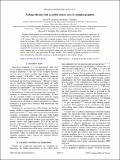Packing efficiency and accessible surface area of crumpled graphene
Author(s)
Cranford, Steven; Buehler, Markus J
DownloadCranford-2011-Packing efficiency and accessible surface area.pdf (813.7Kb)
PUBLISHER_POLICY
Publisher Policy
Article is made available in accordance with the publisher's policy and may be subject to US copyright law. Please refer to the publisher's site for terms of use.
Terms of use
Metadata
Show full item recordAbstract
Graphene holds promise as an ultracapacitor due to its high specific surface area and intrinsic capacitance. To exploit both, a maximum surface area must be accessible while the two-dimensional (2D) graphene is deformed to fill volume. Here, we study stable crumpled graphene sheets of different lengths, L, using full atomistic molecular dynamics (MD) and determine a fractal dimension of D≅2.36±0.12, indicating efficient spatial packing. Introduction of defects inducing a transition from membrane-like to amorphous carbon further enhances packing efficiency. Further, variation of self-adhesion energy indicates a predominant role in randomly folded graphene. We determine that approximately 60% of the specific surface area of graphene is solvent accessible once crumpled and can be tuned with applied compression and crumpling. We analyze the solvent accessible surface area (SASA) and approximate the upper bound of free crumpled graphene capacitance to ≈329 F/g. Once crumpled, the achievable capacitance is highly dependent on the confined volume.
Date issued
2011-11Department
Massachusetts Institute of Technology. Department of Civil and Environmental Engineering; Massachusetts Institute of Technology. Department of Materials Science and Engineering; Massachusetts Institute of Technology. Laboratory for Atomistic and Molecular MechanicsJournal
Physical Review B
Publisher
American Physical Society
Citation
Cranford, Steven, and Markus Buehler. “Packing Efficiency and Accessible Surface Area of Crumpled Graphene.” Physical Review B 84.20 (2011): [7 pages].©2011 American Physical Society.
Version: Final published version
ISSN
1098-0121
1550-235X